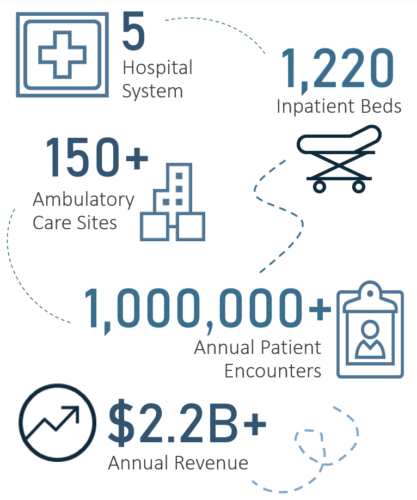Client Overview
MUSC Health is the clinical delivery arm of the Medical University of South Carolina – an AMC located in coastal South Carolina. In 2015, MUSC Health engaged KCG to develop a single-hospital ‘health system’ construct to better align the hospital, physician practice, and academic enterprise. This work included designing the system’s integrated leadership framework, operating model, governance structure, and associated functions.

In 2019, MUSC Health made its first hospital acquisition – four community hospitals – which increased system volume and employees by 50%. To facilitate its transition to a multi-hospital system, KCG was re-engaged to integrate inherited governance bodies & processes from the acquired hospitals into the larger MUSC Health construct.
Engagement Approach
The growing MUSC Health system required a governance structure that was sufficiently regimented to drive alignment across new system assets, while providing enough flexibility to enable Board efficiency and nimble decision making. To this end, KCG partnered with leaders from the hospitals, faculty practice, and College of Medicine to establish a divisional governance model – comprised of a single parent Board and discrete advisory Boards for each new, geographic region – to ensure that new entities were oriented with both regional and system goals, while maintaining relationships with the local community.
Given the existing roles, responsibilities, and relationships between Board members and the local community, transitioning to a new governance structure presented a number of risks. Key considerations for minimizing political risk, enabling effective decision making, and best driving alignment across local and system-level governing bodies included:
1. BOARD RESPONSIBILITIES: The divisional governance model allowed local and parent Boards to split strategic and advisory responsibilities, while maintaining a manageable number of local advisory Boards. Local Boards provided advisory functions for regional hospital entities, whereas the parent Board retained system-wide fiduciary oversight.
2. BOARD COMPOSITION: This model presented a hybrid between the legacy single-parent Board model and the inherited local-level Board model – leveraging cross-representation to encourage diversity & community connection and drive informed & engaged decision making, while minimizing disruption to current governance functionality.
3. SCALABILITY & GROWTH: The divisional governance model was designed to maximize scalability for future planned growth; as additional entities entered the health system, new divisions could be integrated with minimal disturbance to ongoing processes and governance functions.







